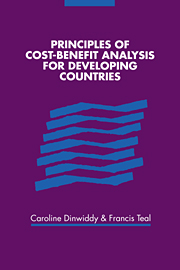Book contents
- Frontmatter
- Contents
- List of figures
- List of economic models and tables
- Preface
- Part I: Introduction to welfare economics
- Part II: Project and policy appraisal in developing countries
- Part III: Missing markets
- 12 Externalities and public goods
- 13 Risk and the measurement of welfare change
- 14 Natural resources and the environment
- Retrospect
- Bibliography
- Index
13 - Risk and the measurement of welfare change
Published online by Cambridge University Press: 22 October 2009
- Frontmatter
- Contents
- List of figures
- List of economic models and tables
- Preface
- Part I: Introduction to welfare economics
- Part II: Project and policy appraisal in developing countries
- Part III: Missing markets
- 12 Externalities and public goods
- 13 Risk and the measurement of welfare change
- 14 Natural resources and the environment
- Retrospect
- Bibliography
- Index
Summary
In the discussion of policy and project appraisal in parts I and II of this book, it was implicitly assumed that cost-benefit analysis takes place in a context in which decision-makers are fully informed about all prices, quantities and available technologies, both now and in the future. Nothing, of course, could be further from the truth. Even in the present, producers and consumers are unlikely to be fully informed about all the options open to them and no-one can ever predict the future with certainty. This means that there is an element of risk in all undertakings, both at the micro level of decisions taken by the individual and at the macro level of public sector policy formation.
Risk raises particularly difficult problems in poor countries. At the macro level, many countries in Africa, for instance, depend on revenues from exports of a relatively narrow range of commodities whose prices vary widely from year to year. At the micro level, many of the poorest people in the world live in rural areas and depend on agricultural activities for their livelihood. Households in such areas are among those whose incomes are most vulnerable and who find it most difficult to protect themselves from the consequences of risk. One of the problems in development economics is that if only the relatively better-off are able to bear the costs of risk and undertake the investments which lead to economic growth, the rich may become richer and the gap between rich and poor may widen further.
- Type
- Chapter
- Information
- Principles of Cost-Benefit Analysis for Developing Countries , pp. 219 - 240Publisher: Cambridge University PressPrint publication year: 1996



